Input interpretation

1-heptanol
Chemical names and formulas
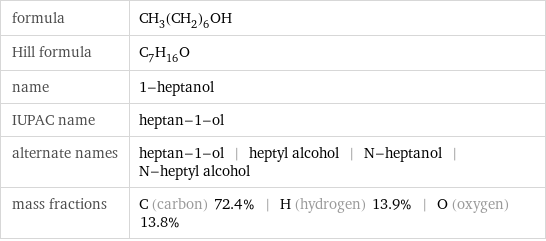
formula | CH_3(CH_2)_6OH Hill formula | C_7H_16O name | 1-heptanol IUPAC name | heptan-1-ol alternate names | heptan-1-ol | heptyl alcohol | N-heptanol | N-heptyl alcohol mass fractions | C (carbon) 72.4% | H (hydrogen) 13.9% | O (oxygen) 13.8%
Lewis structure

Draw the Lewis structure of 1-heptanol. Start by drawing the overall structure of the molecule: Count the total valence electrons of the carbon (n_C, val = 4), hydrogen (n_H, val = 1), and oxygen (n_O, val = 6) atoms: 7 n_C, val + 16 n_H, val + n_O, val = 50 Calculate the number of electrons needed to completely fill the valence shells for carbon (n_C, full = 8), hydrogen (n_H, full = 2), and oxygen (n_O, full = 8): 7 n_C, full + 16 n_H, full + n_O, full = 96 Subtracting these two numbers shows that 96 - 50 = 46 bonding electrons are needed. Each bond has two electrons, so the above diagram has all the necessary bonds. There are 23 bonds and hence 46 bonding electrons in the diagram. Lastly, fill in the remaining unbonded electrons on each atom. In total, there remain 50 - 46 = 4 electrons left to draw: Answer: | |
3D structure
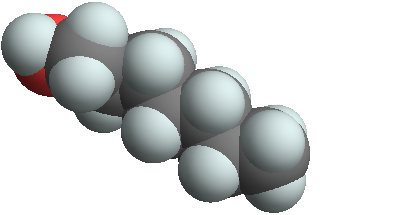
3D structure
Basic properties

molar mass | 116.2 g/mol phase | liquid (at STP) melting point | -36 °C boiling point | 176 °C density | 0.822 g/cm^3 solubility in water | slightly soluble
Units

Liquid properties (at STP)
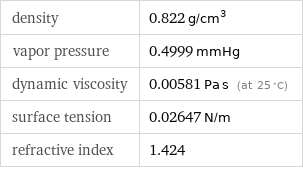
density | 0.822 g/cm^3 vapor pressure | 0.4999 mmHg dynamic viscosity | 0.00581 Pa s (at 25 °C) surface tension | 0.02647 N/m refractive index | 1.424
Units

Thermodynamic properties

specific heat capacity c_p | liquid | 2.342 J/(g K) molar heat capacity c_p | liquid | 272.1 J/(mol K) specific heat of formation Δ_fH° | gas | -2.896 kJ/g molar heat of formation Δ_fH° | gas | -336.5 kJ/mol molar heat of vaporization | 38.71 kJ/mol | specific heat of vaporization | 0.3331 kJ/g | molar heat of combustion | 4638 kJ/mol | specific heat of combustion | 39.91 kJ/g | molar heat of fusion | 18.17 kJ/mol | specific heat of fusion | 0.1564 kJ/g | critical temperature | 632 K | critical pressure | 3.16 MPa | (at STP)
Chemical identifiers
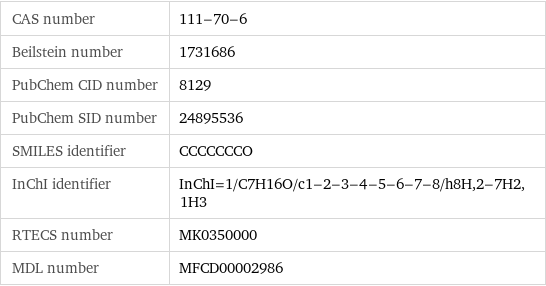
CAS number | 111-70-6 Beilstein number | 1731686 PubChem CID number | 8129 PubChem SID number | 24895536 SMILES identifier | CCCCCCCO InChI identifier | InChI=1/C7H16O/c1-2-3-4-5-6-7-8/h8H, 2-7H2, 1H3 RTECS number | MK0350000 MDL number | MFCD00002986
NFPA label

NFPA label

NFPA fire rating | 2
Safety properties
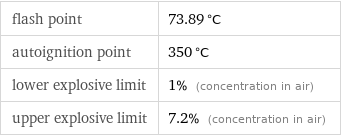
flash point | 73.89 °C autoignition point | 350 °C lower explosive limit | 1% (concentration in air) upper explosive limit | 7.2% (concentration in air)

DOT hazard class | 6.1 DOT numbers | 2810
Toxicity properties

odor | weak alcohol odor threshold | 0.49 ppm

RTECS classes | mutagen